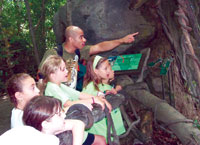|

The
New Zoo: An Educational Experience
By
Tom Kertes
Today’s
zoo is not what your father’s zoo used to be. In fact, over the
past 20 years or so, zoos have gradually morphed from a place
that simply displayed animals in cages, into an environment aiming
to inspire visitors to think about what’s happening in nature.
“The
philosophy behind this is that, with more knowledge and greater
inspiration, people will hopefully do a lot more for the preservation
of animals and nature,” said Annette Berkovits, Sr. Vice President
of Education at the Wildlife Conservation Society.
The Society, which oversees all five major zoos in New York City,
has not only created a plethora of progressively hands-on educational
programs, but has even attempted to make the very act of visiting
the zoo educational.
“We
are now presenting each species in its own natural habitat in
large breeding groups,” said Berkovits. “This allows the visitors
to learn about the animals’ lives in a realistic manner. But,
beyond that, we’ve also embarked on a specific national and international
educational effort. We’ve had 2.2 million people going through
our educational programs just in the last fiscal year.”
The zoo’s effort of making science more hands-on and enjoyable
for students has been a much-needed development. Last year, when
students of the 13 major industrial nations were tested, the U.S.
came in last in the sciences.
“That’s
unacceptable,” said Berkovits. “We aim to change that by bringing
science to as many people as possible, and do it as a living,
breathing experience instead of some kind of a fearsome, dry abstract.”
The programs are three-pronged, but Berkovits sees the Teachers’
Professional Development aspect as the most important.
The Bronx Zoo’s nationally accredited curricula are available
for teachers of grades K-12 in the form of 35-70 hour workshops.
“Research data has clearly shown that participating teachers have
dramatically increased their knowledge in the sciences — and that
this has begun to transcend to their students,” Berkovits said.
In addition, the Society has diverse programs for children at
all levels. “Pablo Python Looks at Animals” has been identified
by the U.S. Dept. of Education as an exemplary life science program
for kids in grades K-3. The “Habitat Ecology Learning Program”
covers the ecology of rain forests and deserts, by cohesively
linking the study of science to social studies, geography, math,
and language arts. For grades 7 and up, “Voyage From the Sun”
is a classroom module designed to introduce students to the
major ways energy is important to wildlife and natural habitats.
And the Wild Science high school curriculum allows students
to use the Internet for an intensive case study of the research
done by each of the 300 field scientists the Society currently
has active in 53 countries around the globe.
“We
believe that by immersing children, as well as their parents and
teachers, in real life situations and issues we enable them to
gain a greater love for and interest in science,” concluded Berkovits.
Education Update, Inc., P.O. Box 20005, New York, NY 10001. Tel:
(212) 481-5519. Fax: (212) 481-3919. Email: ednews1@aol.com.
All material is copyrighted and may not be printed without express consent of
the publisher. © 2001.
|

